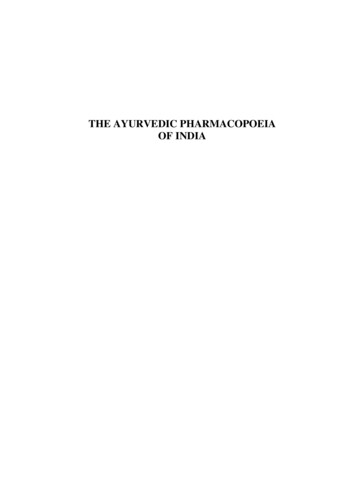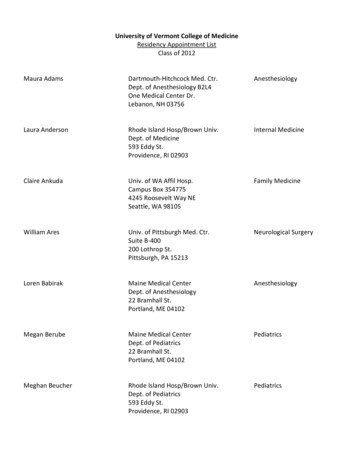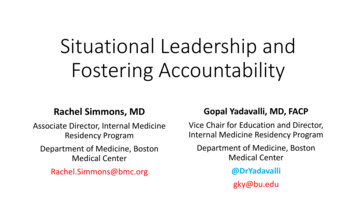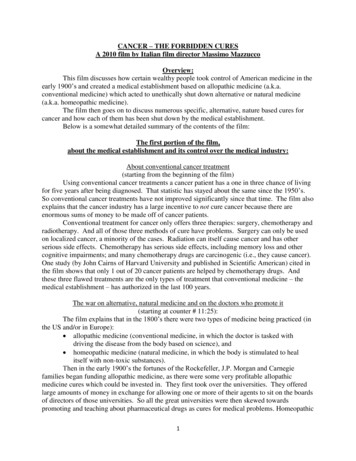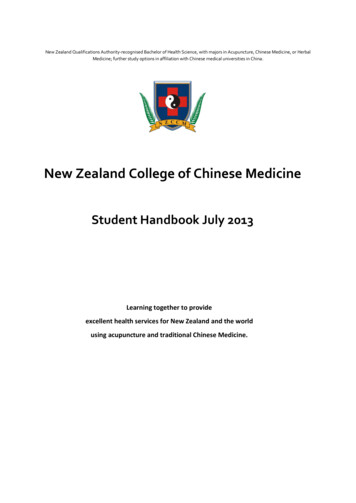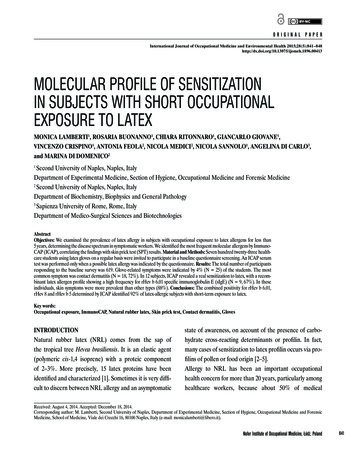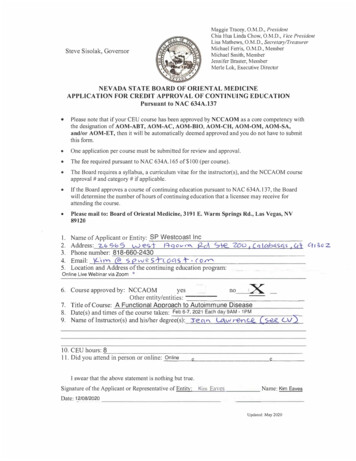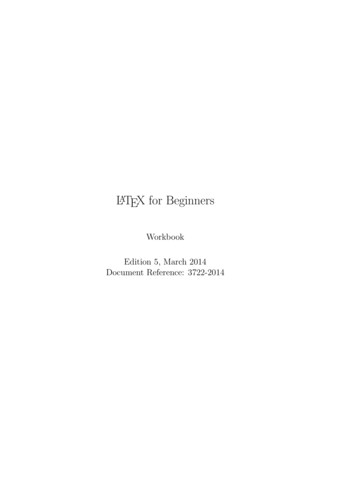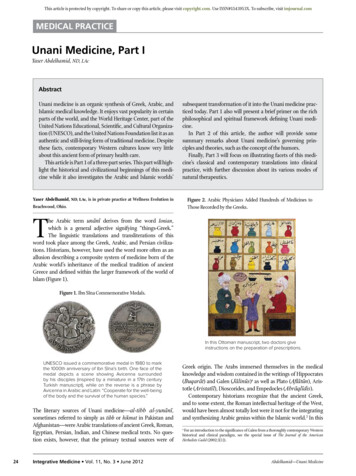
Transcription
This article is protected by copyright. To share or copy this article, please visit copyright.com. Use ISSN#1543953X. To subscribe, visit imjournal.comMedical PracticeUnani Medicine, Part IYaser Abdelhamid, ND, LAcAbstractUnani medicine is an organic synthesis of Greek, Arabic, andIslamic medical knowledge. It enjoys vast popularity in certainparts of the world, and the World Heritage Center, part of theUnited Nations Educational, Scientific, and Cultural Organization (UNESCO), and the United Nations Foundation list it as anauthentic and still-living form of traditional medicine. Despitethese facts, contemporary Western cultures know very littleabout this ancient form of primary health care.This article is Part 1 of a three-part series. This part will highlight the historical and civilizational beginnings of this medicine while it also investigates the Arabic and Islamic worlds’subsequent transformation of it into the Unani medicine practiced today. Part 1 also will present a brief primer on the richphilosophical and spiritual framework defining Unani medicine.In Part 2 of this article, the author will provide somesummary remarks about Unani medicine’s governing principles and theories, such as the concept of the humors.Finally, Part 3 will focus on illustrating facets of this medicine’s classical and contemporary translations into clinicalpractice, with further discussion about its various modes ofnatural therapeutics.Yaser Abdelhamid, ND, LAc, is in private practice at Wellness Evolution inBeachwood, Ohio.Figure 2. Arabic Physicians Added Hundreds of Medicines toThose Recorded by the Greeks.The Arabic term unānī derives from the word Ionian,which is a general adjective signifying “things-Greek.”The linguistic translations and transliterations of thisword took place among the Greek, Arabic, and Persian civilizations. Historians, however, have used the word more often as anallusion describing a composite system of medicine born of theArabic world’s inheritance of the medical tradition of ancientGreece and defined within the larger framework of the world ofIslam (Figure 1).Figure 1. Ibn Sīna Commemorative Medals.In this Ottoman manuscript, two doctors giveinstructions on the preparation of prescriptions.UNESCO issued a commemorative medal in 1980 to markthe 1000th anniversary of Ibn Sīna’s birth. One face of themedal depicts a scene showing Avicenna surroundedby his disciples (inspired by a miniature in a 17th centuryTurkish manuscript), while on the reverse is a phrase byAvicenna in Arabic and Latin: “Cooperate for the well-beingof the body and the survival of the human species.”The literary sources of Unani medicine—al-tibb al-yunānī,sometimes referred to simply as tibb or hikmat in Pakistan andAfghanistan—were Arabic translations of ancient Greek, Roman,Egyptian, Persian, Indian, and Chinese medical texts. No question exists, however, that the primary textual sources were of24Integrative Medicine Vol. 11, No. 3 June 2012Greek origin. The Arabs immersed themselves in the medicalknowledge and wisdom contained in the writings of Hippocrates(Buqarāt) and Galen (Jālinūs)a as well as Plato (Aflātūn), Aristotle (Aristatīl), Dioscorides, and Empedocles (Abrāqlīdis).Contemporary historians recognize that the ancient Greek,and to some extent, the Roman intellectual heritage of the West,would have been almost totally lost were it not for the integratingand synthesizing Arabic genius within the Islamic world.2 In thisFor an introduction to the significance of Galen from a thoroughly contemporary Westernhistorical and clinical paradigm, see the special issue of The Journal of the AmericanHerbalists Guild (2002;3[1]).aAbdelhamid—Unani Medicine
This article is protected by copyright. To share or copy this article, please visit copyright.com. Use ISSN#1543953X. To subscribe, visit imjournal.comregard, one must marvel at the Arabs’ level of care and precisionin “first collecting, then translating, then augmenting, and finallycodifying the classical Greco-Roman heritage that Europe hadlost”3; however,So many people in the West wrongly believe that Islam acted simplyas a bridge over which the ideas of Antiquity passed to medievalEurope. Nothing could be further from the truth; for no idea,theory, or doctrine entered the citadel of Islamic thought unless itbecame first Muslimized and integrated into the total world-viewof Islam. 4Unani Medicine: Comparisons and Contrasts With OtherHealth-care SystemsApart from its impact on world history as a legitimate synthesisof primarily Greek and Islamic civilizational influences, Unanimedicine displays another dimension that is of great importance.Together with the great medical traditions of other civilizations ofthe past, like the Ayurveda of Hindu India or traditional Chinesemedicine (TCM), practitioners continue to preserve Unani medicine. It perseveres, even in the face of modern cultural trendsthat have moved many nations toward exchanging the old guardof ancient medicine for the shiny hopes and promises of a newsystem of powerful drugs, healing steel, and high-tech diagnostictools and machinery.Practitioners still follow the precepts of Unani medicine today,viewing it as an organic, living, breathing, whole system of healthcare. It helps millions of people, especially in the Indian subcontinent, Pakistan, Afghanistan, Iran, China, Indonesia, Malaysia,Bangladesh, Sri Lanka, South Africa, and certain sectors of theMiddle East, such as Saudi Arabia, Kuwait, and the United ArabEmirates. It shares medical theories, philosophies, cultural iden-Table 1. The Three Great Traditional Healing Systems and Modern Western Medicine5UnaniAyurvedaChineseModern WesternOriginsPersia, ca 980 ADIndia, ca 2000 BCEChina, ca 2700 BCEEurope, United States, late19th centuryPrimary dynamicelementsRūh(spirit force)Prana(life breath)Chi(life energy)Brain and heartDisease correlatesHumorsTridoshasYin-yang; chiNamed pathologyDisease causesImbalance of humoral temperamentAma is the “harbinger ofmisery,” the cause of diseaseSystemic imbalances; nooverriding emphasis ononeBacteria, viruses, fungi, parasites, metabolic disturbances,traumaBasis of diagnosis4 humors: blood,phlegm, yellow bile,black bileTridosha (3 humors):vata, pitta, kapha4 methods of diagnosis ofTCM; ie, observation, auscultation, and olfaction;interrogation; pulse taking;and palpationBased on patient’s history,physical examination, laboratory testingDiagnostic modelsRestore balance tohumors and organsystemsConcept of Shiva-Shakti;balance in the tridoshaor 3 humors systemAchieve balance of yin(passive) and yang (active)physiological functionsSpecifically named pathologyChief diagnosticmodalityDifferential, mizāj ortemperamentassessed for each ofthe 4 humorsDifferential, states ofconsciousness alignedwith each of the 3humorsDifferential; questioning,observation, palpation, andlistening; zang fu organsyndromesDifferential, named diseasesDiagnostic testsObservation, lifestyle, pulse, urine,stool, and palpationTongue, pulse, urine,and palpationTongue, pulse, and palpationUrinalysis, radiography, standard blood tests, samplingorgan tissues, diagnosticX-rays, angiography (Note: Inthe United States, medicalpractitioners performed about 16 billion in laboratory diagnostic tests in 2011.6Pulse diagnosisReveals humoralimbalance in organsystem; the physician takes with 3 fingers at radial pulseof wrist; evaluatesmore than 1000potential factors insecondsCorrelates pulse to thetridosha or 3 humors;the physician takes withthe index finger;describes qualities ofthe pulse in terms ofseveral animalsDirect manifestation of thecirculatory energy of thebody; classical 5-phasepulse correspondences;the physician takes on thewrist; about 40% reliableas a sole diagnostic method by most TCM practitionersSpeed: fast pulse vs slowpulseElements of nature4: fire, air, water,earth5: fire, earth, water, air,ether5: fire, earth, metal, water,wood22 basic elements of chemistryAbdelhamid—Unani MedicineIntegrative Medicine Vol. 11, No. 3 June 201225
This article is protected by copyright. To share or copy this article, please visit copyright.com. Use ISSN#1543953X. To subscribe, visit imjournal.comTable 1 (cont.). The Three Great Traditional Healing Systems and Modern Western Medicine5*UnaniAyurvedaChineseModern WesternMain dietary influencesNonalcoholic; regular fasting; nonporcineVegetarianRice and vegetablesRefined sugars, alcohol, fats,drugs,Patient’s participation and willEmpower patient tomake changes indiet and lifestyleHigh objectivityPersonal determinationNot significantDeity of systemAbrahamicMonotheism, primarily God (Allah) ofIslamPolytheistic, pantheistic,nondualistic, gods ofHinduismNontheistic Confucianism,Taoism, BuddhismSecular atheism, agnosticism,modern evolutionary nihilismPrimary treatmentmodalitiesDiet, herbs, fasting,cupping, purgation,baths, attars (essential oils or medicinalscented perfumes)Panchakarma(detoxification),7 herbs,diet, emetic therapiesAcupuncture, herbs, cupping, moxibustion, dietChemotherapy, radiation therapy, pharmaceutical drugs, surgery, rehabilitative physicaltherapyPrimary treatmentobjectiveMizān: restore tobalance, provokethe “healing crisis”Clear the entire gastrointestinal tract, regulatethe bowels, improvedigestionTonification of energySymptom suppression, killinggerms and bacteria, palliativeend-of-life managementSome instrumentsusedGlass cupsGlass cupsGlass cups, acupunctureneedlesOphthalmoscopes, laryngoscopes, radiographs, sphygmomanometers, electrocardiograms, chemical tests of bodyfluids and tissuesSide effectsOverdose of herbalsubstances; veryrareOverdose of herbal substances; very rarePotential for acute symptoms from improper needling techniques or overdose of herbal substances;all very rare106 000 die annually fromimproper medications andfrom severe and frequent drugreactions;d very commonChief complaintsNonregulation ofpractitioners; lack ofclinicsNonregulation of practitioners; lack of clinicsObtuse languageAdverse reactions; patients’dissatisfaction; skyrocketingmedical costsDirection of developmentTraining practitionersin powers of observation; buildingschools; sources forformulationsTraining practitioners;building schools; developing formulationsIntegration with Westernhospital medicineHigher costs; more complexdiagnostics; genetic medicine;new health-care reform lawsTypical cost oftreatment, USD 15-200 150-200 45-300 200-4000Abbreviations: TCM, traditional Chinese medicine.*This is a modified version of the table appearing in the reference.A further explication of this figure:A 1998 report estimated that 106,000 Americans die each year as a result ofadverse reactions to prescription medications. This figure represents three times the numberof people killed by automobiles and is the fourth leading cause of death in the United States.Only heart disease, cancer, and stroke kill more Americans than adverse reactions to drugs.This staggering figure does not include drugs administered in error nor those taken as asuicide gesture. If medication errors were included in this statistic, the death toll wouldprobably be as high as 140,000 deaths per year. As a result of 39 separate studies nationwide, it was found that 3.2 out of every 1000 hospitalized patients die each year as the resultof adverse reactions to prescription drugs in each and every hospital in this country. Of the106,000 people killed each year by an adverse reaction to a prescription drug, 43,000, or41%, were initially admitted to the hospital because of the adverse drug reaction. The other59%, or 63,000 patients, were hospitalized for some other cause but developed a fatal reaction to a prescription drug received while hospitalized.Quoted from Montague P. Another kind of drug problem. Rachel’s Environment & HealthWeekly. January 7, 1999, by grative Medicine Vol. 11, No. 3 June 2012Abdelhamid—Unani Medicine
This article is protected by copyright. To share or copy this article, please visit copyright.com. Use ISSN#1543953X. To subscribe, visit imjournal.comtity, and spiritual insights regarding human health and diseasewith Ayurveda and TCM. Its knowledge and wisdom hail fromthe traditional Eastern “Orient,” while it contrasts tremendouslywith the single system of contemporary medicine common to theworld of the modern Western “Occident.”c On his website, HakimChishti presents a very useful and indexed comparison amongall of the Eastern healing systems whose general points the Tabledetails.dHISTORYContributions and Influences From AntiquityA variety of strands of medicine came together at the crossroads of Islamic history, and they proved to be of tremendoussignificance for the birth of Islamic medicine generally and ofUnani medicine in particular.8First in importance was the synthesis of the sciences (includingmedicine) of the ancient Egyptian and Mesopotamian civilizationsinto Greek life and thought, centered in Alexandria. The worldhas discovered the high level of scientific sophistication presentin those two civilizations only as a result of recent archeologicaland anthropological discoveries.e The Greek intellect forged themedical knowledge of these earlier civilizations into an even moresystematic model of diagnostics and therapeutics.Second, Greco/Hellenistic intellectual energies declined,and the main centers of learning moved further east due to theconstantly shifting economic, political, and religious/theological schisms and realities confronting Christendom (exceptingcontinuation of classical learning in eastern Byzantium). Thisdecline encouraged two other civilizations to take up the reinsof the transmission of essential elements of Greek knowledge:the Persian and the Harrānian (ie, Sabaean). The Sabaeans wereindependent heirs to the Babylonian and Greek scientific estatesthrough their reliance on the wisdom contained in Hermeticismand Neopythagoreanism. Also, in the city of Jundishapur, thePersians enlivened the sciences coming out of India and China. Asscholar David Tschanz has summarized,Scientific knowledge that originated in India, China, and theHellenistic world was sought out by Arab and Muslim scholarsand then translated, refined, synthesized, and augmented atdifferent centers of learning, starting at Jundishapur in Persiaaround the sixth century—even before the coming of Islam—andthen moving to Baghdad,f Cairo, and finally Toledo and Cordoba,from whence this knowledge spread to Western Europe.3The Torchbearers of Islamic MedicineWith regard to the advent of the Islamic spiritual tradition,the author must mention the intellectual power and genius of thephysicians of Islam. If these giants in the field of medicine hadnot been born, the world could not speak in the present tense ofcontemporary Unani medicine at all, let alone identify its subtlehistorical influences upon the character of modern conventionalmedicine.Al-Rāzi (Rhazes): Persia, AD 841-926. Abu Bakr Muhammadibn Zakariyya al-Rāzi was born in the town of Rayy in Persia, nearwhat is present-day Tehran. He is reputed to be Islamic medicine’s greatest clinician (Figure 3). His works include (1) al-KitābAbdelhamid—Unani MedicineFigure 3. Al-Razi Memorialized in Stained Glass atCambridge University’s Medical School, United Kingdom.cPlease see the thoroughly engaging study on this topic by Edward Said, PhD, in his popular book, Orientalism (Vintage Books, 1979). Furthermore, it should go without saying that“Orient” and “Occident” here are terms that transcend time (although one can generalizeand say that the world of antiquity was primarily governed by the laws of tradition and thedictates of heaven) and space (although one can summarize the fact that most of what iscalled the Western world is governed by the laws of secularism dominated by the will ofman).This chart is presented here with some substantive additions and modifications by theauthor of this article to the information as published in the original source, available atwww.unani.com/comparison.htm.deThe lecture, “The Mesopotamian Soul of Western Culture,” by Simo Parpola of TheInstitute for Asian and African Studies, University of Helsinki, explores this topic in greaterdepth. It can be found referenced online at oads/the mesopotamian soul of western culture.pdf.It was in Baghdad, Iraq, where the Caliph Ma’mun founded the very famous Bayt al-Hikma[literally, “House of Wisdom”], a sort of academy in which translators found a convenientworking place equipped with the necessary working facilities in order to conduct the highest quality and quantity of manuscript translations demanded of them by the caliph. SeeManfred Ullmann, Islamic Surveys II: Islamic Medicine (Edinburgh University Press, 1997)for more information.fIntegrative Medicine Vol. 11, No. 3 June 201227
This article is protected by copyright. To share or copy this article, please visit copyright.com. Use ISSN#1543953X. To subscribe, visit imjournal.comal-Mansūri (The Book of Mansūr [Latinized to Liber Almansoris]), wherein Rhazes delineates principles of medical theory,diet, pharmacology, dermatology, oral hygiene, epidemiology,toxicology, and even climatology and its effects on the humanbody; (2) al-Judari wa al-Hasbah (Smallpox and Measles),which was the first treatise ever written on the subject; and (3) hismagnum opus al-Kitāb al-Hāwī (The Comprehensive Workor Liber Continens). This monumental collection of 25 volumescontained all the medical knowledge of the age, including themaster’s own observations and experiences.3Ibn Sīna (Avicenna): Bukhāra (Present-day Uzbekistan), AD 980-1037. Abu ’Ali al-Husayn ibn ’abd Allāh ibnSīna was born in the city of Bukhāra in what today is Uzbekistan.He was the preeminent physician of his time, earning the epithetof “Prince of Physicians” (Figure 4). He began studying medicineat the age of 13, became a physician at 16, attended to kings andprinces at 18, and was appointed as court physician to the rulerof a Persian province at 20. His body of work includes (1) Kitābas-Shifā’ (The Book of Healing), which was primarily a textof encyclopedic proportions on medicine and philosophy and (2)al-Qanūn fi ’l-Tibb (The Canon of Medicine), a one millionword text summarizing the entire Hippocratic and Galenic traditions and describing the Syro-Arab and Indo-Persian medicalpractices of his time. The five-volume Canon quickly became thestandard medical textbook of the Islamic, medieval Christian, andlater Indo-Pakistani worlds.Figure 4. A Portrait of Avicenna.It is from this remarkable polymath thatUnani medicine draws its breath of life.Thus, some historians perceive Avicenna tobe the “father of Unani medicine” and hisCanon its gospel.3Figure 5. Ibn Nafīs’s Formulation of the Pulmonary Circulation.Ibn Naffīs made hisdiscovery of the structureof the pulmonary circulation(the “lesser circulation”) 3centuries before its rediscovery in Europe by MichaelServetus (d. 1553) andRealdo Colombo (d. 1559),both of whom historiansmistakenly had thought forcenturies to have been theoriginal discoverers.Al-Zahrāwī (Albucasis) and Ibn Rushd (Averroes):Morocco and Spain, AD 976-1013 and AD 1126-1198, respectively. Historians consider Abu al-Qāsim al-Zahrāwī fromMorocco to be the greatest surgical figure in Islamic medicine.He also was an original thinker in this medical arena. To conductoperations as painlessly and effectively as possible, he inventedand manufactured the requisite surgical instrumentation when itdid not exist or had existed previously in crude form only. Someof these instruments of surgery have not changed significantly indesign for over 1000 years.hAbu al-Walīd Muhammad ibn Ahmad ibn Muhammad ibnRushd9 was born in Córdoba, Al Andalus (modern-day Spain),where he trained in law and philosophy, although he made hisliving as a physician. He wrote Kitāb al-Kulliyyāt (Latinizedas Colliget [The Book of General Principles]), in which hecovered the whole medical field in abridged form.Figure 6. A Depiction of Humanity’s Place in the Universal Macrocosm.Post-Avicennan MedicineIbn Nafīs: Syria and Egypt, AD 12th century. Ibn Nafīs wasborn in Damascus and died in Cairo in the 12th century AD. Heonly recently gained the fame he rightfully deserves as the discoverer of the lesser or pulmonary circulationg (Figure 5), whichhistorians thought that Michael Servetus had discovered in the16th century.8There are several studies in recent years that demonstrate incontestably that Ibn Nafīs haddiscovered the lesser circulation of the blood before Servetus. See Ayman O. Soubani’s “TheDiscovery of the Pulmonary Circulation Revisited” wherein this medical doctor andresearcher pools together and summarizes a host of earlier literature regarding this hallmark of medical subjects (Ann Saudi Med. 1995;15[2]:185-186).ghFor a more comprehensive sketch of the significance of Albucasis in the field of surgery,see Dr Omar Hasan Kasule Sr’s “Surgery in Islam: A Historical and Current Reappraisal,”his lecture to second-year medical students, Kulliyah of Medicine, International IslamicUniversity, Kuantan; 17 October 1998 egrative Medicine Vol. 11, No. 3 June 2012This depiction shows the seven planetary spheres dominatedby seven prophetic presences (in time and space), surroundedby the lunar and zodiacal influences and encompassed by theangelic sphere signifying the sacred as infinite and beyond.Abdelhamid—Unani Medicine
This article is protected by copyright. To share or copy this article, please visit copyright.com. Use ISSN#1543953X. To subscribe, visit imjournal.comMetaphysical and Philosophical FoundationsUnani medicine’s philosophical underpinnings are tied to theIslamic spiritual tradition. In fact, the true meaning of philosophyas philo-sophia, or “love of wisdom-divine,” has only accidentalaffinities to what is termed philosophy in the modern lexicon.Traditional philosophy as philo-sophia was, and still is, tied to aspiritual vision of humanity and the cosmos (Figure 6).Epistemology and OntologyEpistemology and ontology deal directly with the nature ofknowledge—what something is, how it is obtained, and how it isused—and the study of existence or being. Since Unani medicinestems from the Islamic tradition, historians must search this spiritual source for the answers to questions regarding its theories onknowledge and existence.Within the Islamic as well other traditional religious worlds,knowledge has a definite hierarchical structure.i This hierarchymaintains the essential links that exist between heaven and earth,between God and humankind. First, the hierarchy provides anacknowledgement of a presiding Divine Knowledge. Arisingfrom that Divine Knowledge is the knowledge found in divinerevelation, a perfect dispensation from heaven that enlightensthe human intellect.j And as this revelatory knowledge sparks theheart-intellect, it necessarily begins to involve the mind in its questfor knowledge of this earthly domain (ilm al-dunya), the physicalworld.Ontologically, the being-ness of humanity is intimatelyconnected with the Being of God. God is seen as the Divine Beingwithout which no thing or being can rightfully claim existence foritself. Thus, God’s Being is termed Wājib al-Wujūd (NecessaryBeing). In this light, humanity—and everything else in the worldof forms—is seen as borrowing its existence from the indispensable nature of the Divine Being.in response to the Divine’s “arc of descent.” These adwār (arcsor cycles) of descent and ascent relate directly to the interdependence of all things on all levels of existence.Indeed, these traditions perceive everything in creation asacknowledging, in one form or another, the all-pervading DivinePresence (Figure 7). The traditional view sees the human being asthe most concentrated theophany (ie, locus of Divine Presence inthe world of forms), especially as it concerns the qualities of anactive intellect and free will. According to the Hermetic dictum“As above, so too below, “the human being acts as a mirror tothe Divine. Furthermore, the Sufis (the mystics of Islam) havea popular saying that addresses this reality on the cosmic scale:al-insān qawn saghīr wa ’l-qawn insān kabīr, “Man is a smalluniverse, and the universe is a large man.”Figure 7. Ibn Battūta Mall, Dubai, United Arab Emirates.Cosmology and the Human MicrocosmThe basic cosmological premise in Islam, as well as in othertraditions such as Hinduism, Christianity, and Judaism, is that theAbsolute Truth of Divinity (al-Haqq) manifests itself in the worldof forms and within the human heart in a process called the “arc ofdescent.”k A reciprocal “arc of ascent” of the human spirit10 occursiProfessor Osman Bakar has compiled two wonderful studies on the topic of philosophy(including its epistemological and ontological dimensions) and its relationship to the traditional Islamic sciences in his books entitled Classification of Knowledge in Islam (IslamicTexts Society, 1998) and The History and Philosophy of Islamic Science (Islamic Texts Society,1999).jThe word intellect here is used in its original sense, not as a “fallen word” cut off from itstrue etymologic source as perceived by many of us in the modern world, but as a word signifying that knowing faculty within the human being that knows immediately and withoutrecourse to analytical or discursive thought, a faculty that is constantly in touch with God.It is precisely this faculty of intellectual intuition that the profound mystic of the GermanRhine, Meister Eckhart, described as being the “divine spark” within the human heart thatis the seat of all true knowledge and wisdom.kThere is a famous Qur’ānic verse [41:53] that addresses this claim wherein the “signs” ofGod’s authorship of creation are known most evidently fi ’l-āfāq wa fī anfusihim (“uponthe horizon [of creation] and within their [human] souls”).lFor a scholarly treatment of this subject, see Seyyed Hossein Nasr’s An Introduction toIslamic Cosmological Doctrines (State University of New York Press, 1993).Abdelhamid—Unani MedicineTraditional Islamic cosmological patterns and forms are manifested in parts of buildings, such as the arch and the dome, andin designs, such as sacred geometric patterns like the diamondor star.The guiding principle of the dynamic interplay between theDivine Order and the rest of creation is called Tawhīd, “the principle of Divine Unity.” All traditional sciences agree that creationdepends on the Divine, with interdependence among all formsin the cosmos and intradependence of all elements within eachspecific form. These concepts offer an obvious analogy to theprofound knowledge found in the divine Oriental symbol of theTaoist t’ai chi t’u or “Supreme Principle of Unity,” with the comple-Integrative Medicine Vol. 11, No. 3 June 201229
This article is protected by copyright. To share or copy this article, please visit copyright.com. Use ISSN#1543953X. To subscribe, visit imjournal.commenting and harmonizing forces of yin and yang. This unity isalso known in Islamic cosmological language as “al-wahdah fi’l-kathrah wa ’l-kathrah fi ’l-wahdah,” “the one in the manyand the many in the one.”Unani medicine bases its medical theories of diagnosis andtreatment upon a specific understanding of the intradependentrelationships that exist among the four humors. This knowledgeconcerns the subtle (latīf) aspects of human physiology and ofphilosophical or spiritual psychology.lTeleology and Spiritual CorrespondencesThe teleological component of Unani medicine’s philosophyentails extracting meaning and purpose as it relates to the realitiesof creation and the human experience. To what end is human life?What is the goal of all of creation? Does a plan of purpose existthat governs the created order and all of its particular elements?The Qur’ān explicitly states that “inna li ’Llāhi wa innailayhi rāji”ūn,” “Verily we belong to God and to Him is ourreturn” (2:156). The human race hurtles itself forward in timeand space toward an inevitable reunion with its creator. It is thisunderstanding of the nature of things that permits traditionalhakīms (or doctors of the Unani medical tradition) to find solacein the fact that every patient is ultimately a patient at the doorsteps of the Divine Doctor.The notion of forcing “heroic” measures upon the sacredhuman frame is problematic to the philosophical principles uponwhich Unani medicine is based. This viewpoint in Unani medicinedoes not, however, perceive surgery and trauma care in a negativelight. Rather, the question is really one of proportion. The traditional tabīb (“physician”) always has an eye to the Divine withinthe human temple. This concern is really a cultivated virtue. Thehakīm practices it as part of the art of medicine to remain trueto the doctrine that “God is everywhere present,” that in keepingwith the wisdom of Plato, it is the “eye of the soul” that witnesses“tō Agathōn” (“the Supreme Good”).Therefore, any decision that a hakīm makes must include arisks-to-benefits analysis within the larger ethical framework ofthe Divine’s presence in human life. As a prayerful supplication of ء Ali, the son-in-law of the Prophet Muhammad and the spiritualfounder of Shiite Islam, presents this attitude: “Yā man Ismukadawā’, wa dhikruka shifā,” “Oh Ye whose Name is a sacredmedicine, and in whom remembrance of Thee [dhikruka] is ahealing balm. . .”Editor’s note: Upcoming issues of IMCJ will publish Parts 2 and 3 ofthis series.REFERENCES1. Siddiqui MK. Unani Medicine in India. Centre for Research in Indian Systems ofMedicine. http://www.crism.net/news/pdf/unani medicine overview dr khalidsiddiqui.pdf. Accessed May 17, 2012.2. Venzmer G. Five Thousand Years of Medicine. New York, NY: Taplinger Publishing Co:1972.3. Tschanz DW. The Arab roots of European medicine. Aramco World. 1997;48(3):20-31.4. Nasr SH, Michaud R. Islamic Science: A
Unani Ayurveda Chinese Modern Western Origins Persia, ca 980 AD India, ca 2000 BCE China, ca 2700 BCE Europe, United States, late 19th century Primary dynamic elements Rūh (spirit force) Prana (life breath) Chi (life energy) Brain and heart Disease correlates Humors Tridoshas Yin-yang; chi

